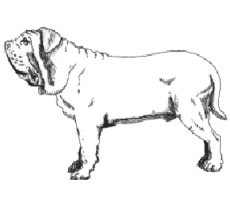Neapolitan Mastiff
A breed standard is the guideline which describes the ideal characteristics, temperament, and appearance of a breed and ensures that the breed is fit for function with soundness essential. Breeders and judges should at all times be careful to avoid obvious conditions and exaggerations, as well as being mindful of features which could be detrimental in any way to the health, welfare or soundness of this breed.
Breed Standard - Neapolitan Mastiff
 General Appearance:
General Appearance: Well boned, large, strongly built, vigorous, alert and muscular. Of majestic bearing, with intelligent expression.
Characteristics: A degree of loose:fitting skin over body and head, with some dewlap, is a feature, not to be excessive.
Temperament: Devoted and loyal guard of owner and property.
Head and Skull: Head large, broad short skull. Broad across cheeks. Head proportion; skull length 2/3 to muzzle 1/3. Top of skull parallel to topline of muzzle. Well pronounced, definite stop, nose should not protrude beyond vertical line of muzzle. Nose large with well opened nostrils, lips full and heavy. Upper lip resembles inverted “V”. Muzzle deep, sides flat and vertical, showing flews. Head deep and spherical.
Eyes: Set forward, well apart, rather rounded. Set fairly deep. Rim pigmentation to tone with nose colour.
Ears: Small for size of head, set forward, high and well apart. Triangular, hanging flat towards cheeks, but not reaching beyond line of throat.
Mouth: Teeth white and regular. Strong, well developed jaws, with scissor bite, but level tolerated. Scissor bite, ie Upper teeth closely overlapping the lower teeth and set square to the jaws.
Neck: Short, stocky, very muscular, dewlap from lower jaw reaching mid:point of neck.
Forequarters: Shoulder long, slightly sloping with well developed and definite muscle. Elbows not too close to body to allow very free action. Pasterns slightly sloping, legs vertical when viewed from front.
Body: Longer than height at withers. Broad, well muscled chest, ribcage reaching at least to elbow. Ribs long and well sprung. Topline straight, slightly lower than withers, line of belly parallel to topline.
Hindquarters: Broad loins, well let into backline, slightly rounded with well developed muscle. Croup broad, muscular, with slight slope. Thigh long, broad, moderate stifle, powerful hocks. Dewclaws (single or double) removed.
Feet: Oval; close, arched toes. Pads thick, hard and dark coloured. Nails curved, strong and dark. Hindfeet slightly smaller than front.
Tail: Thick at root, set on slightly lower than topline. Tapering towards tip. Customarily docked by 1/3 length. Never carried up or over back, but may be carried level with topline when moving.
Gait/movement: Slow, free, bear:like. Slow trot, long steps covering ground well. Rarely gallops.
Coat: Short, dense, even, fine, hard texture. With good sheen. No fringe.
Colour: Preferred black, blue, all shades of grey, brown varying from fawn to red. Brindling on either of the latter colours. Small star on chest and white on toes permissible. Pigmentation to tone with coat colours.
Size: Height - 65-75 cm (26-29 in).
Weight - 50-70 kg (110-154 lb). Some tolerance allowed. Bitches somewhat less.
Faults: Any departure from the forgoing points should be considered a fault and the seriousness with which the fault should be regarded in exact proportion to its degree.
Note: Male animals should have two apparently normal testicles fully descended into the scrotum.
DNZ No 650
Copyright Dogs New Zealand
01 Jan 2002
Any departure from the foregoing points should be considered a fault and the seriousness with which the fault should be regarded should be in exact proportion to its degree and its effect upon the health and welfare of the dog and on the dog’s ability to perform its traditional work.




